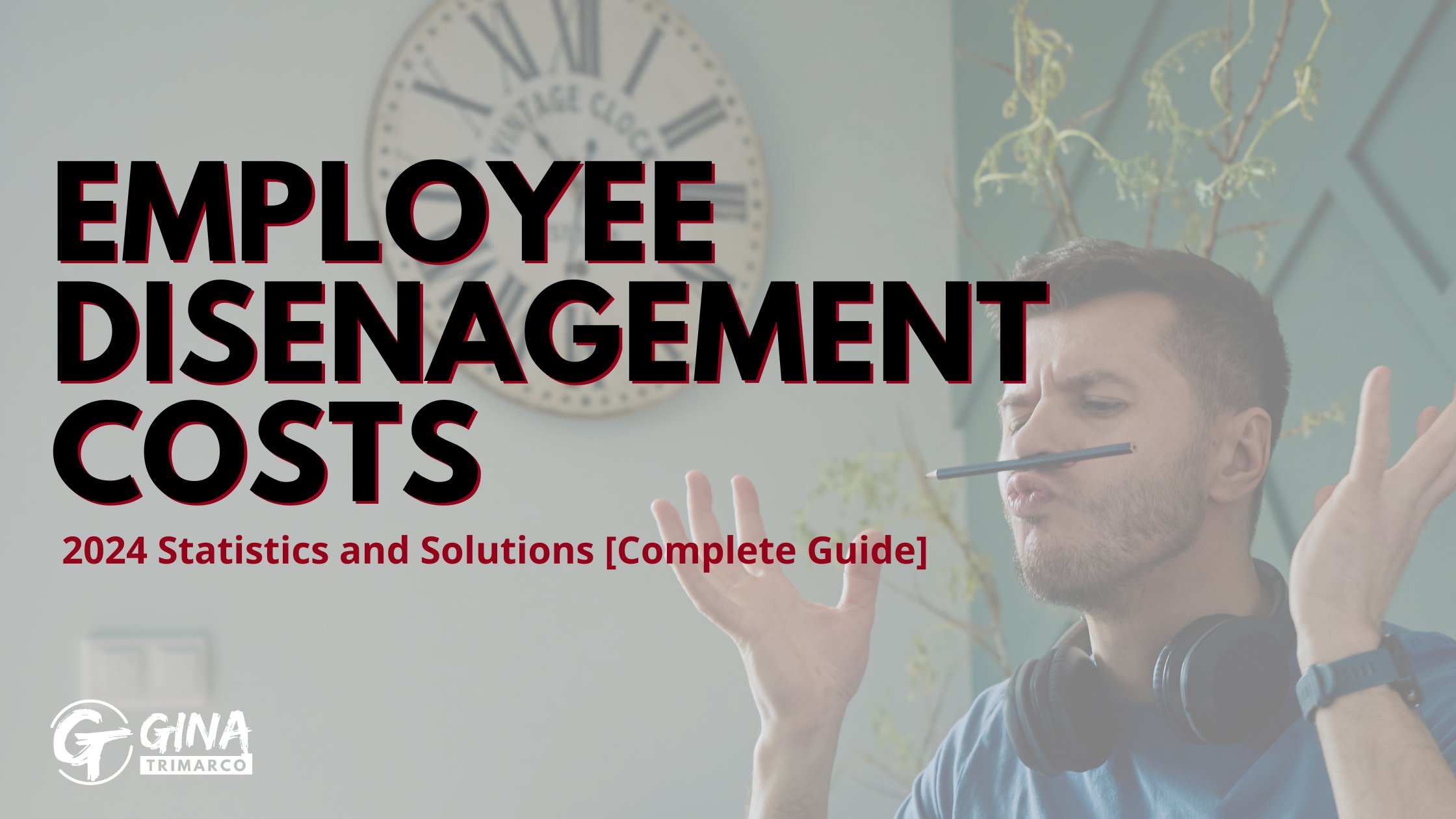By Gina Trimarco
I’ve been diving into the numbers behind employee disengagement in U.S. companies and let me tell you – the figures are shocking. The impact on productivity, profitability, and business performance is far worse than most leaders realize. Let me break down what I’ve found.
The Price Tag Will Make You Wince: The Financial Impact of Employee Disengagement (2024 Statistics)
Here’s what keeps me up at night: employee satisfaction and disengagement is bleeding the U.S. economy of $450-550 billion annually in lost workplace productivity alone. That’s not my number – that’s straight from Gallup’s research about employee engagement statistics for 2024, as reported by ContactMonkey. Even more concerning? McKinsey’s research shows that a typical mid-size S&P 500 company could be hemorrhaging between $228-355 million yearly due to low engagement and employee turnover costs. Do the math over five years, and you’re looking at a potential $1.1 billion loss. That’s billion with a B. And this only scratches the surface on the overall impact of your organizational culture.
The Per-Employee Hit to Your Bottom Line: Calculate Your Employee Disengagement Costs
Let’s get granular about what this means for your business:
- You’re losing at least $2,246 annually for every disengaged employee on your payroll
- Each disengaged worker is costing you 18-34% of their salary
- Just in lost productivity, you’re looking at $3,400-10,000 per disengaged employee
The Ripple Effects Are Even Worse
The financial impact is just the tip of the iceberg. Here’s what else is happening that impacts organizational effectiveness and business performance metrics:
- Disengaged employees are calling in sick 37% more often
- Teams with high disengagement see 18% lower productivity and 15% lower profitability
- Your turnover rates could spike by up to 43%
- Replacing these employees? That’ll cost you 50-200% of their annual salary
Current State of Affairs: 2024 Employee Engagement Benchmark Data
The latest workplace productivity data from 2024 is particularly concerning. Engagement ROI metrics matter:
- Only 30% of U.S. employees are actually engaged at work – the lowest since 2013
- We’ve lost 4.8 million engaged workers since late 2023
- The ratio of engaged to actively disengaged employees has plummeted to 1.8:1, down from 2.1:1 in 2023 and 2.7:1 in 2019
Beyond the Balance Sheet: The Hidden Costs of Workplace Disengagement
The non-financial costs are just as concerning:
- One disengaged employee can poison employee experience, talent retention, and your entire work environment
- They’re undermining your top performers’ excellent work and workplace satisfaction
- Customer loyalty drops by 51% when employees check out
- Your employer brand takes a hit, making it harder to attract talent
What Causes Employee Disengagement?
From my research, here are the main culprits driving disengagement:
- Underwhelming compensation and benefits
- Dead-end career paths
- Poor leadership
- Work-life balance issues
- Toxic company culture
- Lack of recognition
- Rigid work arrangements
- Communication breakdowns
- Leadership disconnection
- Resistance to change
- Employee motivation
- Low workplace morale and team productivity
The Way Forward: Actionable Solutions
The numbers don’t lie – employee disengagement is a silent killer of business performance. Here’s the good news: with the right strategy and commitment to change, we can fix this. The solution lies in doubling down on engagement strategies – better internal communication, real professional development opportunities, and building a culture people actually want to be part of. It’s not just about cutting costs; it’s about building a workplace that drives productivity, sparks innovation, and delivers real business results.
Let me share what I’ve found works best to combat disengagement. It’s not about quick fixes – it’s about systematic changes that create lasting impact.
- Improve Workplace Communication and Culture
Don’t just talk more – communicate smarter:
- Implement a clear two-way feedback system where employees can voice concerns without fear
- Host monthly town halls where leadership shares company vision and progress transparently
- Identify workplace communication tools to create dedicated Slack channels or communication platforms for different departments and projects
- Schedule regular one-on-ones between managers and team members
- Use pulse surveys to catch issues before they become problems
- Share wins and lessons learned across teams to build collective knowledge
- Implement Career Development Programs That Matter
Skip the generic training programs for talent optimization. Instead:
- Create individual development plans that align with both employee goals and company needs
- Offer mentorship programs paired with practical project experience
- Provide learning stipends for courses, certifications, and conferences
- Implement job rotation programs to broaden skill sets
- Create clear career pathways with specific milestones and requirements and include performance management plans
- Support internal mobility by prioritizing internal candidates for new roles
- Build a Culture Worth Staying For
Culture isn’t about ping pong tables – it’s about creating an environment where people thrive:
- Recognize and reward contributions promptly and meaningfully
- Implement flexible work arrangements that respect work-life balance
- Create opportunities for cross-functional collaboration and innovation
- Establish ERGs (Employee Resource Groups) to support diversity and inclusion
- Practice radical transparency about company decisions and performance
- Encourage and support volunteer initiatives and community involvement
- Empower Your Managers
Your frontline leaders make or break engagement:
- Provide leadership development programs focused on emotional intelligence
- Train managers in effective feedback and coaching techniques
- Give them the authority to make decisions that affect their teams
- Hold regular manager forums to share best practices and challenges
- Provide tools and resources for tracking and improving team engagement
- Make engagement metrics part of manager performance evaluations
- Implement workplace culture and productivity assessment tools
- Modernize Your Benefits and Compensation
Think beyond the basic salary package:
- Conduct regular market compensation reviews and adjust accordingly
- Offer personalized benefits packages that employees can customize
- Consider innovative perks like mental health days or sabbaticals
- Implement profit-sharing or equity programs to align interests
- Provide wellness benefits that address physical and mental health
- Create family-friendly policies that support work-life integration
- Measure Success: Engagement Metrics and Analytics
What gets measured gets managed:
- Set clear engagement KPIs and track them regularly
- Use HR analytics to identify engagement patterns and trends
- Conduct stay interviews to understand what keeps top performers
- Run regular engagement surveys and act on the results
- Track the ROI of engagement initiatives with engagement survey tools
- Share progress and adjustments transparently with the team
The investment in these solutions might seem substantial, but remember those costly disengagement figures we discussed earlier. When you’re losing $450-550 billion annually across U.S. companies, spending on engagement isn’t just an expense – it’s an investment with measurable returns.
The key is to implement these solutions systematically and consistently. One-off initiatives won’t cut it. You need a comprehensive strategy that addresses all aspects of the employee experience. Start with one area, measure the results, and build from there.
Remember: engaged employees aren’t just more productive – they’re innovators, brand ambassadors, and the driving force behind customer satisfaction. In today’s competitive market, that’s not just nice to have – it’s essential for survival.



